 Promoted
Promoted
Bald-faced Hornet (Overwintering Queen) - Dolichovespula maculata
I was flipping logs when I uncovered this hornet queen. She wasn't "asleep" yet, but was clearly getting cozy for the winter. I covered her back up right away and moved on!
She was black with characteristic white markings on her head, face, and thorax. Fertilized bald-faced hornet queens overwinter in safe locations, and then start new colonies in the spring. When she becomes active in the spring, she will collect cellulose from rotting wood, chew it up, add some saliva, and then uses this wood/spit concoction to make a nest. Next, she will rear the first brood on her own until they are functional. This first generation will then assume the duties of nest building, food collection, feeding larvae, and protecting the nest.
Bald-faced hornets are valuable predators of flies, caterpillars, and other agricultural pests, in addition to being competent pollinators.
However, they are extremely aggressive in their defense of their nests. Their aggression makes them a threat to people and animals who may wander too close to a nest (even within several feet). They will VIGOROUSLY defend their nest - with workers stinging repeatedly. Bald-faced Hornets have smooth stingers, so they can easily sting numerous times without a problem. In addition, the bald-faced hornet has a unique defense mechanism where it can actually SQUIRT venom from their stingers. They will squirt the venom into the eyes of potential intruders. The venom causes immediate watering of the eyes and temporary blindness.
Habitat: Deciduous forest

"Dolichovespula maculata" is a North American wasp commonly called the bald-faced hornet, bald hornet, white-faced hornet, white-tailed hornet, blackjacket or bull wasp. Its well-known features include its hanging paper nests and the females' habit of defending them with repeated stings.

comments (8)
Posted 5 years ago